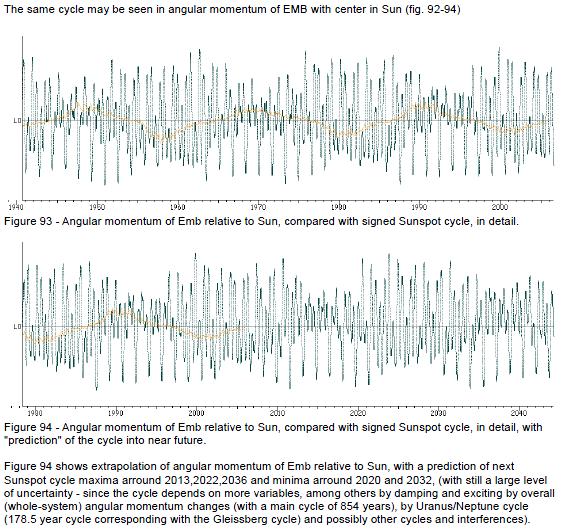Well, this guy has beaten the rest of us to the scoop. A small number of researchers including Geoff Sharp, Gerry Pease, Ian Wilson, Ray Tomes, Ulric Lyons, Gray Stevens, Milivoje Vukevic, Paul Vaughan and myself have been working away on the motion of the planets with respect to the solar system barycentre and various interesting orbital periodicities and resonances. We’ve all found remarkable correlations between various phenomena which hint at a planetary effect on the suns behaviour.
Now Petr Semi Semerad has pulled a lot of things together and discovered the key to the holy grail: the resonances matching the sunspot cycle. But more than that, he has filled the cup to overflowing with a rare vintage of observations which will be keeping us all busy for a long time to come.
Figure 88 -Earth-Venus-Jupiter cycle compared to Signed Sunspot counts
Series in the chart on fig. 88 are:
– Orange – Real data – Signed sunspot counts (every other cycle is negative or positive)
All other series are computed (from ephemerides), at times of Earth-Venus opposition only:
– Bold green (which matches the Sunspot frequency) – Half of angle between Jupiter and Earth (or to EVB, with center in Sun) during Earth-Venus oppositions, multiplied (scaled vertically) by sinus of Uranus-Neptune angle at these times (to match cycle damping arround 1820 and 1910 of the Gleissberg cycle…The Uranus-Neptune cycle of 178.5 years seems to match the length of twice the Gleissberg cycle, observed in the Sunspot data.)
The damping arround 1650 (little ice age) and unexpectedly large values arround 1990 are due to another influences (matches cycle of overall angular momentum change, see relevant chapter)
– Purple series : Uranus/Neptune cycle. To avoid a sinus-like symmetric appearance, the angle between those
planets is multiplied by their relative velocity…
– Pink background serie – Tidal angle between Mercury and Jupiter at times of Earth-Venus oppositions.
– Outer blue serie – with connected maximums to show its envelope (see also fig. 89) – Tidal angle between Earth-Venus barycenter and Jupiter, with added or subtracted (with less importance) the Tidal angle between Jupiter and Mercury.
– Bold blue dots at X axis – historical record of “severe winters” in central Europe.
http://semi.gurroa.cz/Astro/Orbital_Resonance_and_Solar_Cycles.pdf
Download, read and enjoy!
h/t to French-Canadian blogger Simon Filiatrault








